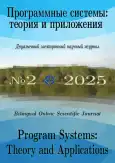Complexity of Computations with Time Travel
- 作者: Joudakizadeh M.1, Beltiukov A.P.1
-
隶属关系:
- Udmurt State University
- 期: 卷 16, 编号 2 (2025)
- 页面: 3-54
- 栏目: theoretical computer science
- URL: https://journal-vniispk.ru/2079-3316/article/view/300936
- DOI: https://doi.org/10.25209/2079-3316-2025-16-2-3-54
- ID: 300936
如何引用文章
详细
作者简介
Milad Joudakizadeh
Udmurt State University
Email: joudakizadeh@mail.ru
PhD student in Artificial Intelligence and Machine Learning, Research focuses on computational complexity, machine learning, and logic in computer science.
Anatoly Beltiukov
Udmurt State University
Email: belt.udsu@mail.ru
Doctor of Physics and Mathematics, Professor. Research focuses on computational complexity, complexity classes, subrecursive hierarchies, intuitionistic mathematics, constructive systems, proof mechanization, proof complexity, computation models, substructural logics, weak arithmetics, and logic in computer science.
参考
- S. A. Cook. „The complexity of theorem-proving procedures“, Logic, automata, and computational complexity: The works of Stephen A. Cook, ed. Kapron B.C., ACM, New York, 2023, ISBN 979-8-4007-0779-7, pp. 143–152.
- R. M. Karp. „Reducibility among combinatorial problems“, 50 Years of Integer Programming 1958–2008. From the Early Years to the State-of-the-Art, eds. Jünger M., et al., Springer, Berlin–Heidelberg, 2010, ISBN 978-3-540-68274-5, pp. 219–241.
- M. R. Garey, D. S. Johnson. Computers and Intractability: A Guide to the Theory of NP-Completeness, Series of Books in the Mathematical Sciences, Freeman, San Francisco, 1979, ISBN 978-0716710455, 340 pp.
- S. Aaronson. „Guest column: NP-complete problems and physical reality“, ACM Sigact News, 36:1 (2005), pp. 30–52.
- D. Deutsch. „Quantum theory, the Church–Turing principle and the universal quantum computer“, Proceedings of the Royal Society A: Mathematical, Physical and Engineering Sciences, 400:1818 (1985), pp. 97–117.
- T. A. Brun. „Computers with closed timelike curves can solve hard problems efficiently“, Foundations of Physics Letters, 16:3 (2003), pp. 245–253.
- S. Aaronson, J. Watrous. „Closed timelike curves make quantum and classical computing equivalent“, Proceedings of the Royal Society A: Mathematical, Physical and Engineering Sciences, 465:2102 (2009), pp. 631–647.
- Ch. Papadimitriou. Computational Complexity, Addison-Wesley, Reading, Massachusetts, 1994, ISBN 978-0201530827, 523 pp.
- S. Arora, B. Barak. Computational Complexity: A Modern Approach, Cambridge University Press, New York, 2009, ISBN 978-0521424264, 594 pp.
- M. A. Nielsen, I. L. Chuang. Quantum computation and quantum information, Cambridge University Press, New York, 2010, ISBN 9781107002173, 702 pp.
- L. K. Grover. „A fast quantum mechanical algorithm for database search“, STOC '96: Proceedings of the twenty-eighth annual ACM symposium on Theory of computing (22–24 May 1996, Pennsylvania, USA), ACM, New York, 1996, ISBN 978-0-89791-785-8, pp. 212–219.
- P. W. Shor. „Algorithms for quantum computation: discrete logarithms and factoring“, Proceedings 35th Annual Symposium on Foundations of Computer Science (20–22 November 1994, Santa Fe, NM, USA), IEEE, 1994, ISBN 0-8186-6580-7, pp. 124–134.
- A. W. Harrow, A. Montanaro. „Quantum computational supremacy“, Nature, 549:7671 (2017), pp. 203–209.
- K. Iqbal, O. Ahmad, A. Y. Vandika. „Quantum computing and its implications for complex system analysis“, Research of Scientia Naturalis, 1:5 (2024), pp. 238–247.
- J. I. Orlicki. Time-travelling Turing Machines and the self-consistent Halting Problem, 2024.
- K. Gödel. „An example of a new type of cosmological solutions of Einstein's field equations of gravitation“, Rev. Mod. Phys., 21:3 (1949), pp. 447–450.
- D. Bacon. „Quantum computational complexity in the presence of closed timelike curves“, Phys. Rev. A, 70:3 (2004), 032309.
- D. H. Wolpert. „Physical limits of inference“, Physica D: Nonlinear Phenomena, 237:9 (2008), pp. 1257–1281.
- A. D. King, J. Raymond, T. Lanting, R. Harris, A. Zucca, F. Altomare, A. J. Berkley, K. Boothby, S. Ejtemaee, C. Enderud, E. Hoskinson, Sh. Huang, E. Ladizinsky, A. J. R. MacDonald, G. Marsden, R. Molavi, T. Oh, G. Poulin-Lamarre, M. Reis, Ch. Rich, Y. Sato, N. Tsai, M. Volkmann, J. D. Whittaker, J. Yao, A. W. Sandvik, M. H. Amin. „Quantum critical dynamics in a 5,000-qubit programmable spin glass“, Nature, 617:7959 (2023), pp. 61–66.
- G. L. Miller. „Riemann's hypothesis and tests for primality“, STOC '75: Proceedings of the seventh annual ACM symposium on Theory of computing (5–7 May 1975, Albuquerque, New Mexico, USA), ACM, New York, pp. 234–239.
补充文件










